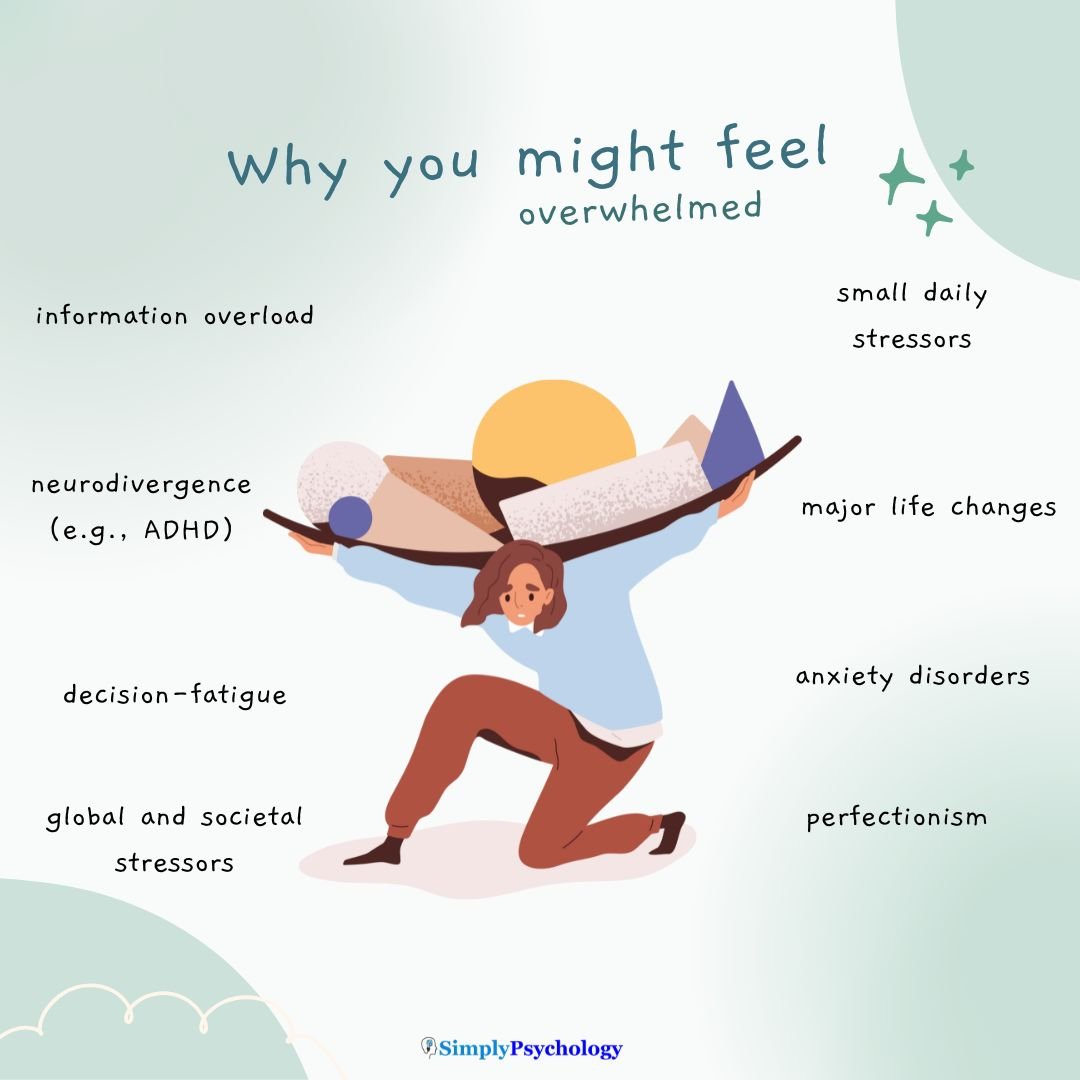Have you ever felt like you’re drowning in responsibilities, emotions, or expectations? When everything is overwhelming, it can feel impossible to cope—like even small tasks take enormous effort.
You’re not alone. Many people experience emotional overwhelm, especially in our fast-paced, high-pressure world.
Download our free reflection sheet on this topic:
Feeling Overwhelmed Reflection Sheet
This article will help you make sense of overwhelm, recognize the signs, and guide you toward realistic, compassionate steps for relief.
What Does It Mean to Feel Overwhelmed?
Emotional overwhelm happens when stress exceeds your ability to cope. It’s the sensation of being flooded—mentally, emotionally, and sometimes physically—by more input than your brain or body can process.
You might feel flooded by thoughts, emotions, and physical signs that can feel like too much. You may feel paralyzed by decisions, overreact to small things, or cry without knowing why.
Mindfulness expert Jon Kabat-Zinn notes that this state often arises when “our lives are somehow unfolding faster than the human nervous system and psyche can manage well.”
When too many demands hit at once—work, relationships, news, personal struggles—it can become impossible to respond calmly or logically.
Importantly, feeling overwhelmed isn’t a personal failure. It’s a natural human reaction to being overextended. The problem isn’t you—it’s the load you’re carrying.
Common Causes of Overwhelm
Overwhelm is rarely caused by one issue. It often builds gradually, a result of several pressures piling up. Here are the most common triggers:
1. Major Life Changes
Sudden changes—like losing a loved one, going through a breakup, or starting a new job—can disrupt your sense of stability. Even positive transitions can be emotionally demanding.
“I had just moved cities, started a new job, and broken up with my partner all within a month. I wasn’t sad—I was just completely fried.”
— Emma, Reddit user (r/mentalhealth)
2. Global and Societal Stressors
We’re constantly exposed to distressing news: wars, pandemics, climate disasters, political unrest, inflation. Even if these events aren’t happening to you directly, they activate your stress response.
This phenomenon is sometimes called “headline stress disorder”—a term coined by psychologist Dr. Steven Stosny to describe the anxiety and helplessness people feel from nonstop media exposure.
“Our nervous systems didn’t evolve to handle global crises in real time, every day,” says Dr. Jenny Taitz, a clinical psychologist and author of Stress Resets.
These stressors don’t just live on your screen. They linger in your body—fueling anxiety, anger, and despair.
3. Chronic Stress and Burnout
Taking on too much at once—especially without rest—leads to physical and emotional burnout. Caregivers, parents, and professionals often reach a breaking point when they’re stretched too thin.
4. Anxiety Disorders
People with anxiety often feel overwhelmed by their own thoughts. Worry loops, racing thoughts, and catastrophizing can amplify stress even when nothing major is happening.
6. Neurodivergence (e.g., ADHD)
ADHD can make everyday tasks feel chaotic. Many with ADHD describe feeling overwhelmed by decisions, stimuli, and time management challenges.
“My brain is loud and chaotic 24/7. I get overwhelmed by the idea of making lunch. Then I beat myself up for that too.”
— Jordan, Reddit user (r/ADHD)
6. Information Overload
Constant notifications, breaking news, and social media comparisons flood our minds with more data than we can absorb. This contributes to mental fatigue.
7. Sensory or Emotional Sensitivity
Highly sensitive people (HSPs) and those with trauma histories may react strongly to noise, crowds, or emotional triggers. This sensitivity isn’t a weakness—it just requires different coping strategies.
Recognizing the Signs of Overwhelm
Overwhelm doesn’t look the same for everyone. Still, there are common symptoms across mental, emotional, and physical domains:
Emotional Signs
- Feeling helpless, anxious, or like you’re “failing at life”
- Sudden irritability or unexplained tears
- Avoiding people or social situations
Mental Signs
- Racing or looping thoughts
- Trouble focusing or making simple decisions
- Mental paralysis: knowing what to do, but being unable to start
“I sit there knowing I have to do the dishes, send emails, shower—but my body won’t move. I just freeze.”
— Aria, Reddit user (r/Anxiety)
Physical Signs
- Tension headaches or jaw pain
- Rapid heartbeat or shallow breathing
- Sleep problems or fatigue despite resting
- Changes in appetite (overeating or not eating at all)
You’re Not “Too Sensitive”—You’re Human
It’s easy to internalize overwhelm as weakness. You might think, Everyone else is coping—why can’t I?
But the truth is, the modern world is overstimulating, demanding, and often scary. Many people feel overwhelmed not because they’re failing, but because they’re reacting appropriately to overwhelming circumstances.
“Pretty much everyone is overwhelmed these days. The only way to survive is to stop judging others—and yourself—for struggling.”
— Casey, Reddit user (r/depression)
Self-criticism only adds to your stress. Compassion and rest are the real antidotes.
Practical Steps to Reduce Overwhelm
Here are tools you can use right away to feel more grounded. You don’t need to do all of them—start with one or two that feel doable.
1. Breathe Intentionally
When you’re overwhelmed, your breathing tends to become shallow and rapid—fueling anxiety. Intentional breathing resets your body’s alarm system and signals safety.
Try this breathing technique:
- Sit or lie down in a comfortable position.
- Inhale slowly through your nose for a count of 4.
- Hold your breath for a count of 4.
- Exhale slowly through your mouth for a count of 6–8.
- Repeat this cycle for at least 2 minutes.
Tip: Place one hand on your chest and one on your belly. Focus on making your belly rise and fall more than your chest—that’s a sign you’re breathing deeply.
2. Do a Thought Dump
Grab a notebook or open a blank document. Write down everything on your mind—worries, tasks, fears—without editing. Then highlight just one thing you can do today.
This turns chaos into clarity.
3. Simplify Your Day
When everything feels urgent, the pressure can freeze you. Narrowing your focus helps you take action without panicking.
Try this:
- Do a quick “brain dump”—write down everything on your mind or to-do list.
- Circle or highlight just one thing that feels important and doable today.
- Break that task into the smallest possible step. For example:
- Instead of “clean kitchen,” write: “Put one dish in the sink.”
- Instead of “reply to emails,” write: “Open inbox and respond to one message.”
Tip: Set a timer for 10 minutes and do only that task. When the timer ends, decide if you want to keep going or rest.
4. Say No or Ask for Help
Set small boundaries: say no to non-urgent tasks, postpone a meeting, or ask someone to take over a chore. Your bandwidth is limited—and protecting it is necessary.
“Even letting your friends know you’re overwhelmed and need help can be a relief. You don’t have to explain everything.”
— Dr. Joy Harden Bradford, licensed psychologist and host of Therapy for Black Girls
5. Give Yourself Permission to Rest
When you’re overwhelmed, rest can feel unearned. But pushing through without breaks only deepens the burnout. Even short moments of rest can help regulate your emotions.
Try this:
- Tell yourself: “I’m overwhelmed, and I need 15 minutes of non-doing.”
- Set a timer for 15 minutes and do something that requires no productivity:
- Lie down and close your eyes.
- Sit outside and listen to the wind or birds.
- Watch clouds, drink tea, or stare out the window.
Tip: Resist the urge to multitask during this time. No checking your phone or catching up on chores—just pause.
6. Engage Your Senses
Try grounding techniques:
- Hold a cold object (like a glass of ice water)
- Splash cool water on your face
- Use the 5-4-3-2-1 method (name 5 things you see, 4 you hear, etc.)
These reset your attention to the present and reduce anxiety loops.
7. Do One Enjoyable Thing
Even five minutes of something enjoyable—music, drawing, a favorite video—can soothe your nervous system and remind you that not everything is urgent.
When to Be Concerned
Overwhelm is a normal reaction to life’s demands. But when it becomes constant or begins to interfere with daily functioning, it may be a sign of something more serious.
Signs It Might Be More Than Everyday Stress:
- You feel overwhelmed nearly every day, even when nothing significant has happened.
- Minor tasks feel impossible or provoke anxiety.
- You avoid responsibilities or withdraw socially.
- You experience strong emotional reactions to small problems.
- You feel hopeless, numb, or burned out.
The National Institute of Mental Health advises that persistent overwhelm may be a symptom of anxiety, depression, or trauma-related conditions. If these feelings last more than a few weeks or are impacting your health, it’s important to seek help.

